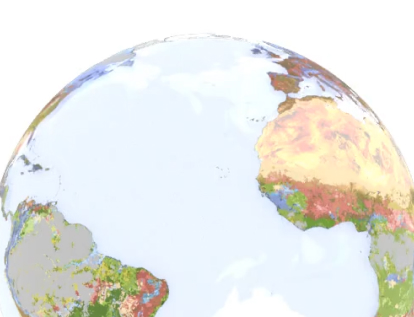Foodscapes
Accelerating a global food system transition
How do we feed the world?
The need for food is a universal constant, but how it’s produced is different across the globe.
To understand this, let’s explore the production of soy.
Think of it in layers.
Food production is defined by a region’s environmental conditions, farming practices, market forces, distribution challenges, public policies and local communities and cultures. This context can be clustered into three main layers.
Physical geography
Distinct geographic features are the foundation of food production. This includes the soil makeup, climate, topography, land cover, freshwater access or the qualities of a seabed.
Soy favors midsummer mean temperatures of 24ºC to 25ºC (75ºF to 77ºF). It is often produced in the plains with deep fertile soils called Mollisols, or on tropical soils in South America.
Management patterns
This layer encompasses the practices producers use to grow food, such as irrigation techniques, tillage or the level of nutrient inputs.
Almost all soy is rainfed, and a large majority is produced in high-intensity systems, where field size is large and agricultural inputs are high. Over the last 30 years, global demand for soy (and beef) has driven the conversion of millions of acres of native habitat and forests.
Socioeconomic influences
This layer zooms out to contextualize the foodscape by including market forces, distribution challenges, public policies and local communities and cultures.
More than three-quarters of global soy is fed to livestock for meat and dairy production. Most of the rest is used for biofuels, industry or vegetable oils. Just 7% of soy is used directly for human food products such as tofu, soy milk, edamame beans and tempeh.
Source: Soy - Our World in Data.
These layers overlap to create a foodscape.
A foodscape is a specific area of food production, defined by the combination of biophysical characteristics and management attributes in that area.
Simply put, a foodscape maps a portion of the global food system, categorized by ecological and human influences.
At this time, soy is being produced in several foodscapes around the world.
In 2010
More than 240 million tons of soy was produced across nearly all 83 different foodscapes. Of that, almost 68% comes from intensive production systems, where field size is large and agricultural inputs are high.
In 2010
Just one of these 83 different foodscapes produces 19% of soy globally. It is characterized by its deep fertile soils called Mollisols that are found in the world’s plains, its rainfed irrigation, and its single-cropped fields of cereal and oil. Let us focus on this foodscape.
A Globally Distributed Foodscape
It is interesting to note that the same foodscape favored by soy accounts for 1.4% of the global agricultural landscape, spanning 5 continents. These similarities offer a good starting point to learn from and apply to similar foodscapes across the globe.
Why think of soy in foodscapes?
Mapping and analyzing foodscapes reveal the food system transitions needed to meet this century’s most pressing challenges: the threats posed by the climate crisis, biodiversity loss, and increased demand for the integrity of the global food system.

Think of it in layers.
Food production is defined by a region’s environmental conditions, farming practices, market forces, distribution challenges, public policies and local communities and cultures. This context can be clustered into three main layers.
Physical geography
Distinct geographic features are the foundation of food production. This includes the soil makeup, climate, topography, land cover, freshwater access or the qualities of a seabed.
Soy favors midsummer mean temperatures of 24ºC to 25ºC (75ºF to 77ºF). It is often produced in the plains with deep fertile soils called Mollisols, or on tropical soils in South America.
Management patterns
This layer encompasses the practices producers use to grow food, such as irrigation techniques, tillage or the level of nutrient inputs.
Almost all soy is rainfed, and a large majority is produced in high-intensity systems, where field size is large and agricultural inputs are high. Over the last 30 years, global demand for soy (and beef) has driven the conversion of millions of acres of native habitat and forests.
Socioeconomic influences
This layer zooms out to contextualize the foodscape by including market forces, distribution challenges, public policies and local communities and cultures.
More than three-quarters of global soy is fed to livestock for meat and dairy production. Most of the rest is used for biofuels, industry or vegetable oils. Just 7% of soy is used directly for human food products such as tofu, soy milk, edamame beans and tempeh.
Source: Soy - Our World in Data.
These layers overlap to create a foodscape.
A foodscape is a specific area of food production, defined by the combination of biophysical characteristics and management attributes in that area.
Simply put, a foodscape maps a portion of the global food system, categorized by ecological and human influences.
At this time, soy is being produced in several foodscapes around the world.
In 2010
More than 240 million tons of soy was produced across nearly all 83 different foodscapes. Of that, almost 68% comes from intensive production systems, where field size is large and agricultural inputs are high.
In 2010
Just one of these 83 different foodscapes produces 19% of soy globally. It is characterized by its deep fertile soils called Mollisols that are found in the world’s plains, its rainfed irrigation, and its single-cropped fields of cereal and oil. Let us focus on this foodscape.
A Globally Distributed Foodscape
It is interesting to note that the same foodscape favored by soy accounts for 1.4% of the global agricultural landscape, spanning 5 continents. These similarities offer a good starting point to learn from and apply to similar foodscapes across the globe.
Why think of soy in foodscapes?
Mapping and analyzing foodscapes reveal the food system transitions needed to meet this century’s most pressing challenges: the threats posed by the climate crisis, biodiversity loss, and increased demand for the integrity of the global food system.

